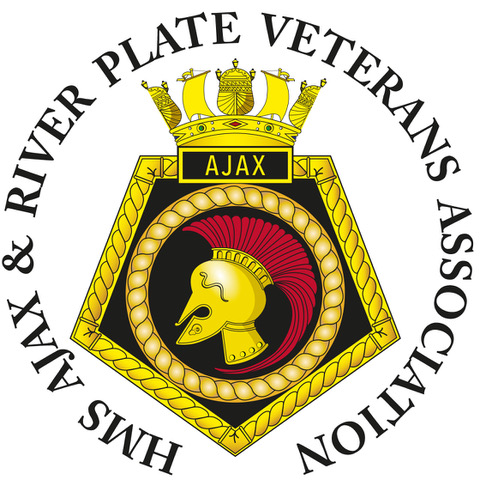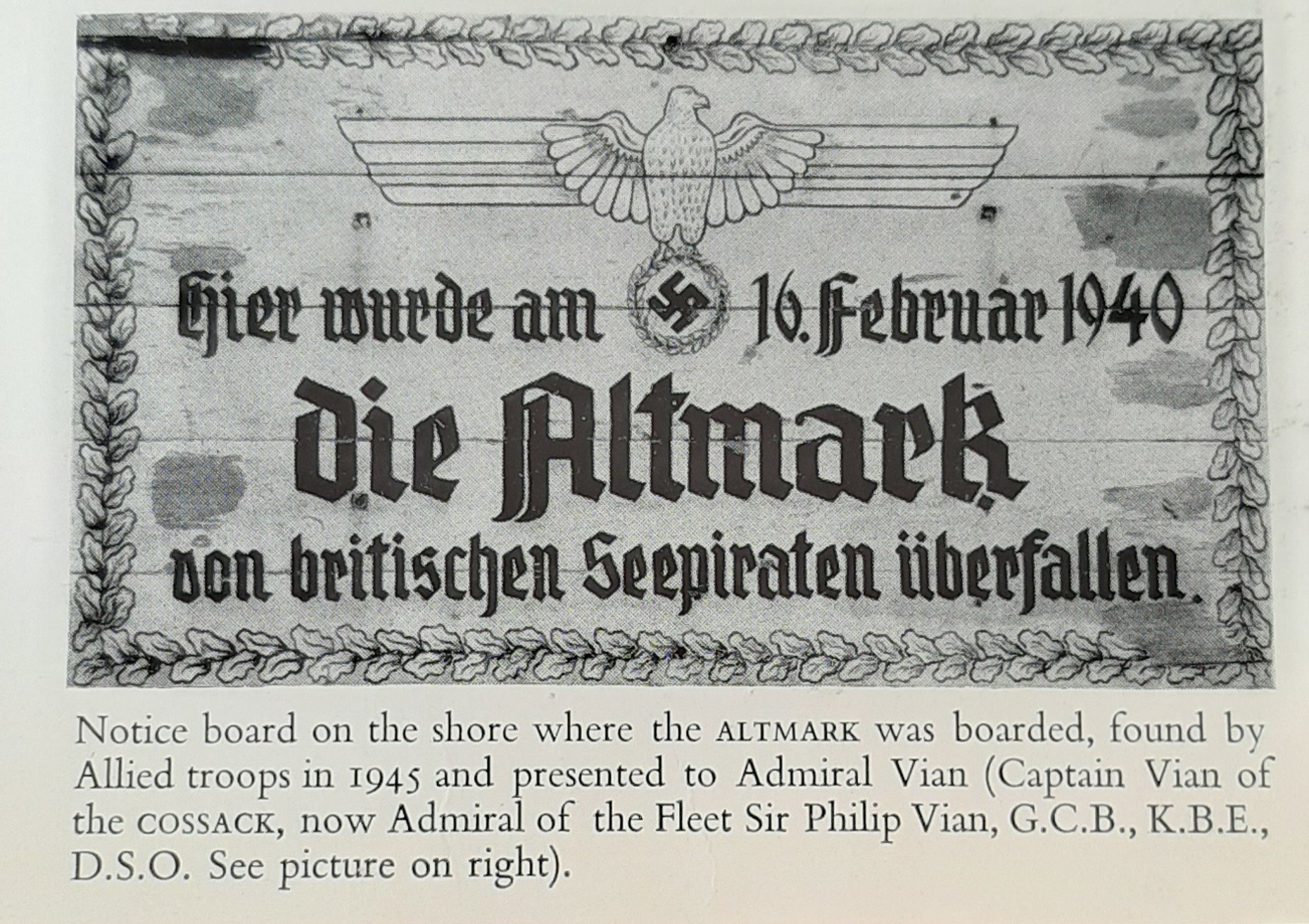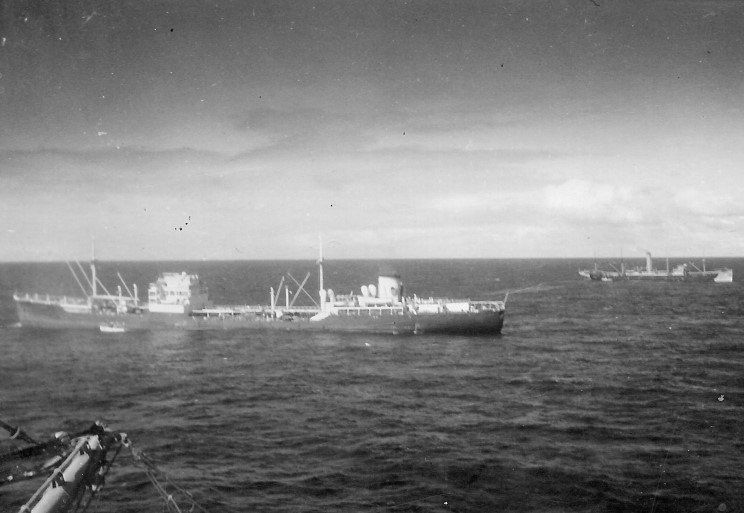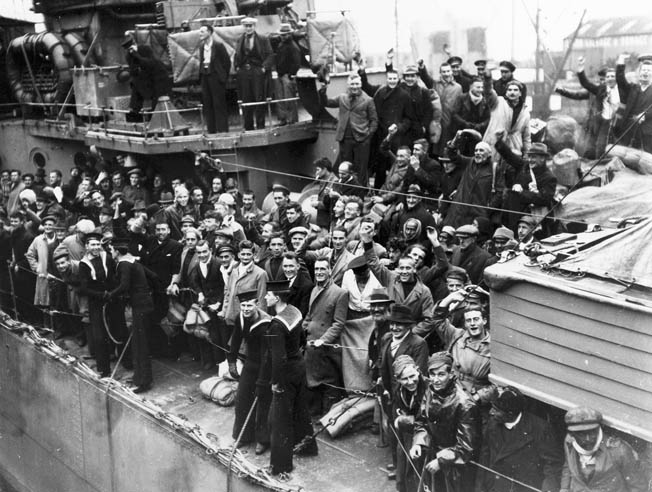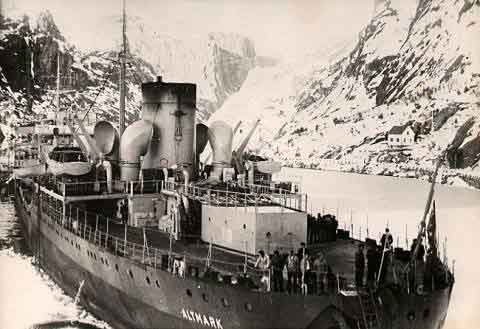The Altmark
German Tanker Altmark
Altmark was an 11,000-ton oil tanker, 176 metres [540 feet] long with a beam of 21 metres [70 feet]. Her 4 nine-cylinder diesel engines gave her a top speed of 21 knots. She had a cargo capacity of 14,000 tons.
Altmark was laid down 15 June 1936 and built by Howaldtswerke at Kiel. Launched 13 November 1937 and commissioned 14 August 1939
and was captained by Heinrich Dau.
Dau, a seasoned and strict merchant seaman, was born in 1874 and joined the Imperial Navy in October 1898 and served throughout WW1 on battleships but under the Treaty of Versailles navy numbers were reduced and he left and joined the Merchant Navy. During WW1 he had been imprisoned in England for a considerable time and it is said as a result he had no love for the British.
Altmark had sailed with the Graf Spee before during Spanish Civil War patrols.
Whilst supporting Graf Spee, particularity the guarding of somewhere in the region of 300 transferred prisoners that far outnumbered his guards, Dau maintained strict discipline to prevent an overthrow or accident bearing in mind vast quantities of fuel and ammunition for Graf Spee were being carried.
On the day war was declared Altmark had been at a refinery in Port Arthur, Texas taking on a full load of fuel for the coming months. The crew, with the exception of Dau, were unaware of the ship’s secret military orders. She set sail for Rotterdam, the crew believed, until Dau assembled the 134 crew on deck and informed them that they were now on active military service as the supply ship to the Admiral Graf Spee. They would not be returning to Germany for at least four months.
During the voyage Dau ordered the crew to repaint Altmark’s standard black-and-white to light yellow and displayed the name Sogne and new port of origin, Oslo, endeavouring to appear a neutral merchant ship.
Except for a close call with one of HMS Ark Royal’s spotter planes near the Cape Verde Islands on 9 October 1938, Altmark successfully evaded detection – had she been captured or sunk by the Allies, Graf Spee’s reign would almost certainly have been over. Altmark was highly successful in keeping Graf Spee going and apart from a shortage of carbonic acid for maintaining the temperature of the ammunition, kept her well supplied; although the speed of replenishment was questionable and rendered both ships vulnerable at such times.
Graf Spee had retained one British merchant captain on board when she rendezvoused with Altmark on 27 November 1939 and re-transferred from Altmark to Graf Spee more of the captains and officers and those in need of medical attention, 27 in all, to ease the pressure on Altmark. [they would be released in Montevideo after the Battle of the River Plate].
Their final rendezvous was on 6th December when another 144 prisoners were transferred to Altmark and Graf Spee refuelled. They parted company; Graf Spee on a final sweep of the South Atlantic before intending to head home.
Following the Battle of the River Plate on 13 December 1939 the Altmark cruised the South Atlantic awaiting orders. On 22 January 1940 she made for Germany where the captured British sailors would be used as propaganda. She crossed the equator on 31 January reaching the North Atlantic trade routes by 9 February and despite seeing British vessels Dau successfully evaded detection on his journey. On 11 February they were passing Iceland reaching neutral Norwegian waters on 14 February. However, on 16 February 1940 the British Cruiser HMS Arethusa with the 4th Destroyer Flotilla intercepted her in company with two small Norwegian war ships who warned the British not to interfere with the Altmark.
Commander Vian [later Admiral of the Fleet] of the 4th Flotilla aboard HMS Cossack received orders from Winston Churchill to board Altmark even though she was in Norwegian waters. The Altmark tried to take cover in Jossingfjord, a narrow inlet south of Stavanger, Norway, but was pursued by the destroyer HMS Cossack. Altmark tried to ram the Cossack but in doing so ran aground allowing specially trained and equipped men from the Cossack to storm aboard the Altmark. Fierce hand-to-hand fighting ensued but the Germans were soon overcome. The 12 armed guards escaped onto the ice floe where a gun battle took place leaving 6 of them dead and 6 badly wounded; one Royal Navy crew was shot but survived.
The tanker was searched by the British and the 299 prisoners were released and taken on board the Cossack. The Altmark was allowed to re-float on the next tide and continue on its way. The Norwegians were not impressed by the actions of the British, but in Britain there was cheering when the news was heard.
Hitler was so enraged by this incident that he ordered the invasion and occupation of Norway.
On 6 August 1940 Altmark was renamed the Uckermark under a new captain and returned to service. On 30 November 1942 in Yokohama harbour, Japan, resupplying the German auxiliary cruiser Thor, she suddenly exploded and sank. Sabotage was suspected but never proved.
Following the Altmark incident, Captain Dau was forced to retire and remained in Germany. He took his own life on the day that the Nazis surrendered in May 1945.
